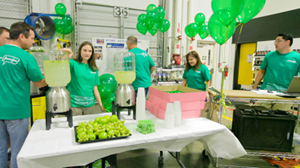DC Velocity & CSCMP’s Supply Chain Quarterly conducted a survey on the challenges in achieving payback on software. When asked about the biggest obstacle faced when deploying a software solution, the top results were integration, company culture (employee acceptance and support), and a lack of IT resources and user training.
This is common knowledge around the Lucas offices. Our mission is to improve the lives of supply chain workers and supervisors by working smarter. It’s no secret that end-user acceptance is directly tied to implementation success. If employees are not engaged, acceptance will be slow, and you’re going to be leaving gains on the table and lowering employee morale.
Based on our experience implementing hundreds of systems around the world, here are six ways to ensure employee adoption and, in turn, implementation success.
Get end-users involved early
Include end users in the decision process. This shows that you value their opinions. And while their voices should not be the only ones, hearing their concerns up front allows you to address them early and build momentum towards the end goal.
One Lucas customer, The Container Store, did this particularly well. When they were looking to implement warehouse optimization solutions in their DC, they formed a functional team that included some “power users” who would be end users of the technology. In addition to providing their own input, they helped the others keep in mind the needs of those who would be using the system the most.
Choose a user-friendly technology.
Make sure the technology is user-friendly and easy to learn for all users – from temp hires to 20-year veterans of your DC, from millennials to boomers. Technology that’s user-friendly will make work more enjoyable for your employees.
Chris Rufa, Senior Director of Global Distribution at Apex Tool Group stated, “You rarely implement a new system and have users tell you ‘It’s made my life so much easier.‘ Making the process better for associates makes them more productive. And that’s better for the business.”
The goal is to provide a solution that will help everyone do their best work by anticipating differing skill levels and abilities. Therefore, Lucas mobile applications have a beginner mode that provides additional context and data to new users while they ramp up, and also an advanced mode that allows expert users to condense many steps into one step, saving time.
Communicate the value.
Make sure employees understand how the system will benefit them and what they stand to gain. This can overcome fear of the unknown and a sense that the current way of doing things is good enough.
For example, we encourage new customers to explain to pickers how voice-directed mobile applications will enable them to more easily hit their goal rates and earn any associated bonuses. A selector at Pate Dawson said it best when asked, what does Jennifer™ (the brain, voice and orchestration engine of the Lucas system) mean to you? “More money.” A clear understanding of the technology’s value to them can turn employees’ apprehension into excitement and support.
Demonstrate management support.
By involving management throughout the implementation process, you communicate to employees that this is an important project, that it affects everyone, and that you are committed to making the change successful.
During customer implementations of our system, we encourage supervisors and managers to learn all aspects of the system, not just the management console, but also the mobile applications that their employees will be interacting with every day. In addition to showing solidarity with employees as they deal with change, this gives management insight into how the change will (and will not) affect hourly associates.
Have employees teach each other.
Use the first employees trained on the new technology as a training team to roll out the system to their peers. Since teaching others requires clear knowledge of the technology, trainers will quickly become power users. Plus, employees have rapport with their peers that can go a long way to easing the transition to new tools and processes.
Most of our customers who roll out our software to multiple distribution centers or across multiple areas in the DC use this “train the trainer” method. By having some employees present at training and go-live who have already been through an implementation, you can ensure consistency in the use of the technology and build a sense of excitement and teamwork around the training.
Make it fun!
Find a way to make the launch of the new technology fun and out of the ordinary for employees. The exact method you use to do this can vary depending on your company culture and what your employees find motivating.
For example, The Container Store launched their use of our software with a DC-wide celebration (and then had a birthday party for “Jennifer™” a year after that). The launch party included contests, food, and free t-shirts with the voice-commands printed upside down.
Additionally, in their picking application The Container Store requested special voice prompts by Jennifer™ (e.g, “Wahoo!”) to keep the fun going after the go-live celebration died down. Watch the case study here →
Making the Process Better for Associates Makes Them More Productive
So there you have it – six ways to successfully get employees excited and engaged with your technology rollout. If you’d like to discuss how best to execute on these recommendations, or if you’d like to share some of your own ideas, we’d love to hear from you.






